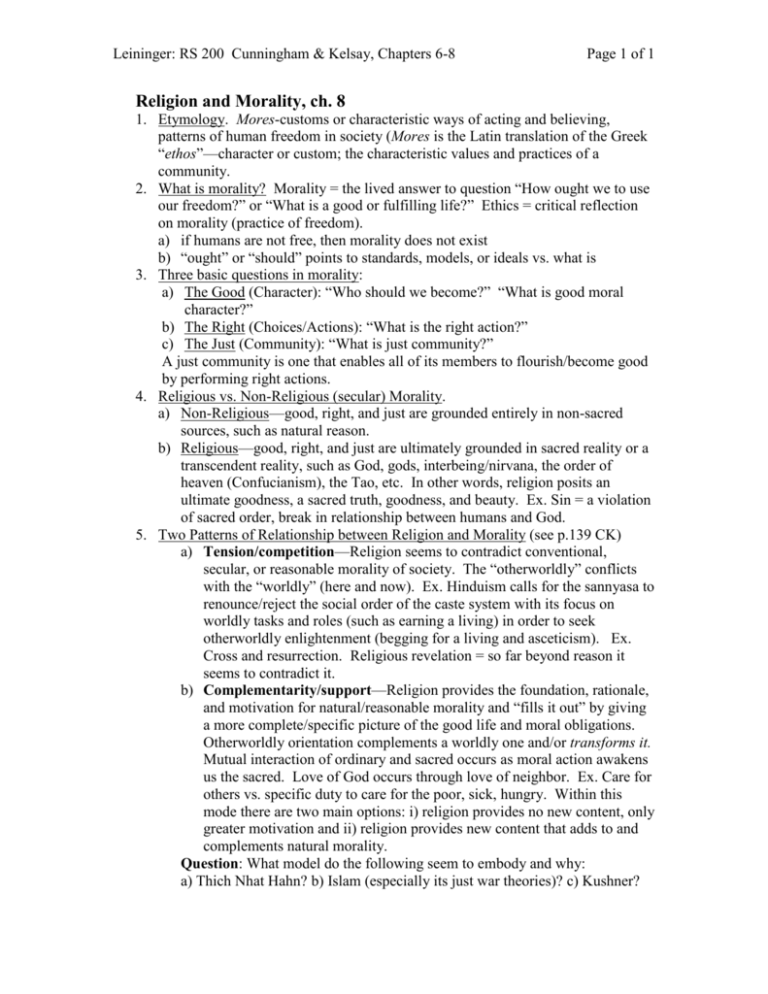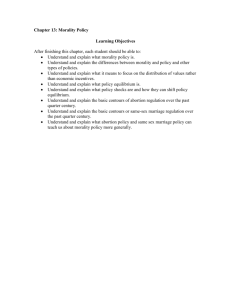CK 8 & Leininger: Religion and Morality
advertisement

Leininger: RS 200 Cunningham & Kelsay, Chapters 6-8 Page 1 of 1 Religion and Morality, ch. 8 1. Etymology. Mores-customs or characteristic ways of acting and believing, patterns of human freedom in society (Mores is the Latin translation of the Greek “ethos”—character or custom; the characteristic values and practices of a community. 2. What is morality? Morality = the lived answer to question “How ought we to use our freedom?” or “What is a good or fulfilling life?” Ethics = critical reflection on morality (practice of freedom). a) if humans are not free, then morality does not exist b) “ought” or “should” points to standards, models, or ideals vs. what is 3. Three basic questions in morality: a) The Good (Character): “Who should we become?” “What is good moral character?” b) The Right (Choices/Actions): “What is the right action?” c) The Just (Community): “What is just community?” A just community is one that enables all of its members to flourish/become good by performing right actions. 4. Religious vs. Non-Religious (secular) Morality. a) Non-Religious—good, right, and just are grounded entirely in non-sacred sources, such as natural reason. b) Religious—good, right, and just are ultimately grounded in sacred reality or a transcendent reality, such as God, gods, interbeing/nirvana, the order of heaven (Confucianism), the Tao, etc. In other words, religion posits an ultimate goodness, a sacred truth, goodness, and beauty. Ex. Sin = a violation of sacred order, break in relationship between humans and God. 5. Two Patterns of Relationship between Religion and Morality (see p.139 CK) a) Tension/competition—Religion seems to contradict conventional, secular, or reasonable morality of society. The “otherworldly” conflicts with the “worldly” (here and now). Ex. Hinduism calls for the sannyasa to renounce/reject the social order of the caste system with its focus on worldly tasks and roles (such as earning a living) in order to seek otherworldly enlightenment (begging for a living and asceticism). Ex. Cross and resurrection. Religious revelation = so far beyond reason it seems to contradict it. b) Complementarity/support—Religion provides the foundation, rationale, and motivation for natural/reasonable morality and “fills it out” by giving a more complete/specific picture of the good life and moral obligations. Otherworldly orientation complements a worldly one and/or transforms it. Mutual interaction of ordinary and sacred occurs as moral action awakens us the sacred. Love of God occurs through love of neighbor. Ex. Care for others vs. specific duty to care for the poor, sick, hungry. Within this mode there are two main options: i) religion provides no new content, only greater motivation and ii) religion provides new content that adds to and complements natural morality. Question: What model do the following seem to embody and why: a) Thich Nhat Hahn? b) Islam (especially its just war theories)? c) Kushner?







